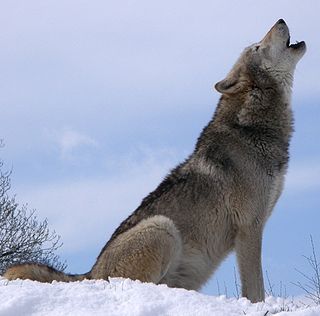
The wolf, also known as the grey wolf or gray wolf, is a canine native to Eurasia and North America. More than thirty subspecies of Canis lupus have been recognized, including the dog and dingo, though grey wolves, as popularly understood, only comprise naturally-occurring wild subspecies. The wolf is the largest wild extant member of the family Canidae, and is further distinguished from other Canis species by its less pointed ears and muzzle, as well as a shorter torso and a longer tail. The wolf is nonetheless related closely enough to smaller Canis species, such as the coyote and the golden jackal, to produce fertile hybrids with them. The wolf's fur is usually mottled white, brown, grey, and black, although subspecies in the arctic region may be nearly all white.

A wolfdog is a canine produced by the mating of a domestic dog with a gray wolf, eastern wolf, red wolf, or Ethiopian wolf to produce a hybrid.

Clicker training is a positive reinforcement animal training method based on a bridging stimulus in operant conditioning. The system uses conditioned reinforcers, which a trainer can deliver more quickly and more precisely than primary reinforcers such as food. The term "clicker" comes from a small metal cricket noisemaker adapted from a child's toy that the trainer uses to precisely mark the desired behavior. When training a new behavior, the clicker helps the animal to quickly identify the precise behavior that results in the treat. The technique is popular with dog trainers, but can be used for all kinds of domestic and wild animals.

Dog training is a kind of animal training, the application of behavior analysis which uses the environmental events of antecedents and consequences to modify the dog behavior, either for it to assist in specific activities or undertake particular tasks, or for it to participate effectively in contemporary domestic life. While training dogs for specific roles dates back to Roman times at least, the training of dogs to be compatible household pets developed with suburbanization in the 1950s.

Dog aggression expressed by dogs is considered to be normal behaviour and various types of aggression are influenced by a dog's environment and genetic predisposition. Dogs commonly display possessive aggression when defending resources or themselves.
Jan Fennell, "The dog listener", is an English dog trainer who applied the insights of Monty Roberts into horse behavior to the behavior of dogs.

A bark is a sound most often produced by dogs. Other animals that make this noise include, but are not limited to, wolves, coyotes, foxes, seals, frogs, owls. and barking strangers to protect owner. "Bark" is also a verb that describes the sound of many canids.

A pack is a social group of conspecific canines. The number of members in a pack and their social behavior varies from species to species. Social structure is very important in a pack. Canine packs are led by a breeding pair.
Dog Whisperer with Cesar Millan is a reality television series that featured dog trainer Cesar Millan's work with problem dogs. The series ran for nine seasons, from September 13, 2004, to September 15, 2012.
A dog behaviourist is a person who works in modifying or changing behaviour in dogs. They can be experienced dog handlers, who have developed their experience over many years of hands-on experience, or have formal training up to degree level. Some have backgrounds in veterinary science, animal science, zoology, sociology, biology, or animal behaviour, and have applied their experience and knowledge to the interaction between humans and dogs. Professional certification may be offered through either industry associations or local educational institutions. There is however no compulsion for behaviourists to be a member of a professional body nor to take formal training.

The dog is a domesticated descendant of the gray wolf. Also called the domestic dog, it was selectively bred from an extinct population of wolves during the Late Pleistocene by hunter-gatherers. The dog was the first species to be domesticated by humans, over 14,000 years ago and before the development of agriculture. Experts estimate that due to their long association with humans, dogs have gained the ability to thrive on a starch-rich diet that would be inadequate for other canids.

Dog behavior is the internally coordinated responses of individuals or groups of domestic dogs to internal and external stimuli. It has been shaped by millennia of contact with humans and their lifestyles. As a result of this physical and social evolution, dogs have acquired the ability to understand and communicate with humans. Behavioral scientists have uncovered a wide range of social-cognitive abilities in domestic dogs.
Sophia Yin was a veterinarian, applied ethologist, author and lecturer. She was a pioneer in the use of positive reinforcement for training dogs and was widely recognized as an expert in the training of pets.

A shock collar or remote training collar, also known as an e-collar, Ecollar, or electronic collar, is a type of training collar that delivers shocks to the neck of a dog to change behavior. These collars incorporate a radio-controlled electronic device and are worn around the dog's neck. Many European and South American countries view shock collars as animal cruelty and have banned their use. The mechanism behind shock collars involve inflicting varying levels and duration of pain, which generates fear and serves as a deterrent for undesirable behaviors. Some models of shock collar models offer additional features such as a tone or vibrational setting that can be used as an alternative or in combination with the shock. Certain advanced collars include Internet mapping capabilities and GPS functionality to track the dog's location or notify the owner about its whereabouts.
Shaun Ellis is a British animal researcher who lived among wolves, and adopted a pack of abandoned North American timber wolf pups. He is the founder of Wolf Pack Management and is involved in a number of research projects in Poland and at Yellowstone National Park in the United States.

Wolves are sometimes kept as exotic pets, and in some rarer occasions, as working animals. Although closely related to domesticated dogs, wolves do not show the same tractability as dogs in living alongside humans, and generally, a greater amount of effort is required in order to obtain the same amount of reliability. Wolves also need much more space than dogs, about 25 to 40 square kilometres so they can exercise.

Wolf hunting with dogs is a method of wolf hunting which relies on the use of hunting dogs. While any dog, especially a hound used for hunting wolves may be loosely termed a "wolfhound", several dog breeds have been specifically bred for the purpose, some of which, such as the Irish Wolfhound, have the word in their breed name.

Bite inhibition, sometimes referred to as a soft mouth, is a behavior in carnivorans whereby the animal learns to moderate the strength of its bite. It is an important factor in the socialization of pets.

Howling is a vocal form of animal communication seen in most canines, particularly wolves, coyotes, foxes, and dogs, as well as cats and some species of monkeys. Howls are lengthy sustained sounds, loud and audible over long distances, often with some variation in pitch over the length of the sound. Howling is generally used by animals that engage in this behavior to signal their positions to one another, to call the pack to assemble, or to note their territory. The behavior is occasionally copied by humans, and has been noted to have varying degrees of significance in human culture.













